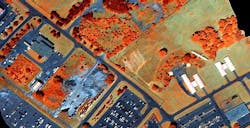Raytheon to move hyperspectral sensor program ACES Hy forward with podded flight tests
Officials of the Air Force Life Cycle Management Center (AFLCMC) at Wright-Patterson Air Force Base, Ohio, have announced plans to negotiate a contract with the Raytheon Co. Space and Airborne Systems segment in McKinney, Texas, to flight test a podded version of the Airborne Cueing and Exploitation System-Hyperspectral, otherwise known as ACES-Hy.
Raytheon won a four-year contract in November 2012 for ACES-Hy engineering development and integration onto the MQ-1 Predator medium-endurance UAV.
Related: Hyperspectral imaging sensors come into their own for aerospace and defense applications
Raytheon is working on ACES-Hy sensor development, as well as working to qualify the ACES-Hy sensor processing subsystem. Raytheon is prime systems integrator for ACES-Hy program, and leads team members L3 Integrated Optical Systems and Exelis Space Computer Corp.
The Air Force awarded a $2.1 million contract to Exelis Space Computer in Los Angeles in fall 2012 to upgrade ACES-Hy sensor processor. Exelis in McLean, Va., acquired Space Computer in mid-2012.
The ACES-Hy hyperspectral sensor can detect light across a wide bandwidth of the electromagnetic spectrum to enable military surveillance experts to detect the composition of specific objects based on their spectral signatures. It is particularly effective at detecting improvised explosive devices (IEDs) by its ability to detect disturbed dirt.
Related: Raytheon produces airborne hyperspectral sensor for U.S. Air Force
Hyperspectral imaging collects and processes information from across the electromagnetic spectrum, unlike the human eye, which sees visible light in only three bands: red, green, and blue. Hyperspectral sensors divide the spectrum into many more bands, and includes non-visible spectra.
ACES Hy detects optical bands the near-visible to the midwave infrared spectrum, which makes it suitable for deciphering camouflage and aerosols that might emanate from bomb-making locations.
Exelis Space Computer specializes in advanced sensor processing, with an emphasis in hyperspectral sensor data. Company experts have developed real-time and off-line hyperspectral processing tools to help evaluate advanced sensor system data. Exelis Space Computer provides algorithms, real-time processor hardware, system integration, custom applications, sensor system data analysis, and field support.
For more information contact Raytheon Space and Airborne Systems online at www.raytheon.com, Exelis Space Computer Corp. at www.spacecomputer.com, or the Air Force Life Cycle Management Center at www.wpafb.af.mil/aflcmc.
